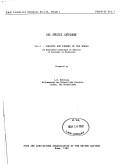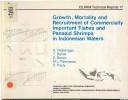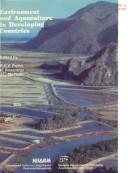
ISBN: 9251008965 9789251008966 Year: 1980 Volume: 125,1 Publisher: Rome FAO
Abstract | Keywords | Export | Availability | Bookmark
 Loading...
Loading...Choose an application
- Reference Manager
- EndNote
- RefWorks (Direct export to RefWorks)
Shrimp fisheries. --- Shrimps. --- Shrimp fisheries --- Prawn fisheries --- Shellfish fisheries --- Shrimps --- #ABIB:FAOdeposit --- Macroura --- Macrura --- Natantia (Decapoda) --- Prawns --- Shrimp --- Decapoda (Crustacea) --- Fisheries
Dissertation
Abstract | Keywords | Export | Availability | Bookmark
 Loading...
Loading...Choose an application
- Reference Manager
- EndNote
- RefWorks (Direct export to RefWorks)
Artemia --- Vibrio --- Contrôle de maladies --- Disease control --- Stress thermique --- Heat stress --- 595.323.1 --- 579.843.1 --- 639.3.09 --- 639.512 --- Branchipodidae. Artemia --- Diseases of fish. Pests, enemies of fish --- Shrimps and prawns --- Theses --- 639.512 Shrimps and prawns --- 639.3.09 Diseases of fish. Pests, enemies of fish --- 579.843.1 Vibrio --- 595.323.1 Branchipodidae. Artemia
Dissertation
Abstract | Keywords | Export | Availability | Bookmark
 Loading...
Loading...Choose an application
- Reference Manager
- EndNote
- RefWorks (Direct export to RefWorks)
Penaeidae --- Penaeus monodon --- Élevage de crustacés --- Crustacean culture --- Performance de ponte --- Laying performance --- Performance animale --- Animal performance --- Performance de reproduction --- Reproductive performance --- Écloserie piscicole --- fish hatcheries --- Viet Nam --- 639.512 --- <597> --- Shrimps and prawns --- Vietnam --- Theses --- <597> Vietnam --- 639.512 Shrimps and prawns
Dissertation
Abstract | Keywords | Export | Availability | Bookmark
 Loading...
Loading...Choose an application
- Reference Manager
- EndNote
- RefWorks (Direct export to RefWorks)
Macrobrachium rosenbergii --- Élevage de crustacés --- Crustacean culture --- Méthode d'élevage --- animal husbandry methods --- Matériel d'élevage --- Animal husbandry equipment --- Viet Nam --- 639.512 --- <597> --- Shrimps and prawns --- Vietnam --- Theses --- 639.3 <597> --- 639.3.041 --- Fish breeding. Pisciculture. Aquaculture--Vietnam --- Hatching out --- 639.3 <597> Fish breeding. Pisciculture. Aquaculture--Vietnam --- <597> Vietnam --- 639.512 Shrimps and prawns
Book
ISBN: 9789251057353 Year: 2007 Publisher: Rome : FAO,
Abstract | Keywords | Export | Availability | Bookmark
 Loading...
Loading...Choose an application
- Reference Manager
- EndNote
- RefWorks (Direct export to RefWorks)
Penaeus monodon --- Élevage de coquillages et crustacés --- Shellfish culture --- Méthode d'élevage --- animal husbandry methods --- Santé animale --- Animal health --- India --- 639.512 --- Shrimps and prawns --- Shrimp culture --- Zoology and Animal Sciences. Aquaculture and Fisheries --- Management --- Aquaculture --- Husbandry and Management --- Husbandry and Management. --- 639.512 Shrimps and prawns
Book
ISBN: 9251048118 Year: 2002 Publisher: Rome FAO
Abstract | Keywords | Export | Availability | Bookmark
 Loading...
Loading...Choose an application
- Reference Manager
- EndNote
- RefWorks (Direct export to RefWorks)
639.512 --- 595.384.12 --- Shrimps and prawns --- Carididae --- Macrobrachium rosenbergii. --- Shrimp culture. --- Zoology and Animal Sciences. Farm and Captive Animals --- Zoology and Animal Sciences. Aquaculture and Fisheries --- Cultured Shellfish and Crustaceans --- Aquaculture --- Cultured Shellfish and Crustaceans. --- Aquaculture. --- 595.384.12 Carididae --- 639.512 Shrimps and prawns
Dissertation
ISBN: 9789086491995 Year: 2008 Publisher: Leuven Katholieke Universiteit Leuven. Faculteit Wetenschappen
Abstract | Keywords | Export | Availability | Bookmark
 Loading...
Loading...Choose an application
- Reference Manager
- EndNote
- RefWorks (Direct export to RefWorks)
Insulin-like peptides are key regulators of metabolism, reproduction, and senescence in higher eukaryotic organisms. They have been described in different invertebrates, including nematodes, molluscs, and insects, where they form a structurally diverse group encoded by large multi-gene families. Insulin-like peptides have also been detected in some decapod crustaceans, where they may display typical insulin effects. On the basis that common biological function may be related to a similar structure, we searched for an insulin-related substance in the shrimp Litopenaeus vannamei and further investigated its function. A former study on adult Litopenaeus vannamei reported the presence of a peptidic factor in the CNS with the capability to stimulate Y-organ ecdysteroidogenesis in vitro. This factor was proposed to be a potential regulator of molt in crustaceans. Two attempts for its purification were undertaken starting from an extract of juvenile CNS. A partial sequence of 7 residues corresponding to a molecular mass 864.4 Da was obtained. This fragment showed sequence similarities with a peptide precursor from the salmon louse Lepeophtheirus salmonis and it could represent a form of the Crustacean Hyperglycemic Hormone (CHH-B). The remaining bioactive material is still under analysis in order to obtain a complete sequence. An IGF-I-like molecule was detected in neurosecretory cells of the brain and thoracic ganglion in shrimps at different molt stages. This IGF-like factor seems to be contained in secretory granules. Bombyxin, the first insulin-like peptide identified in insects was isolated based on its ability to stimulate ecdysteroidogenesis in the prothoracic glands. Therefore, we investigated the effects of mammalian insulin/IGF-I on ecdysteroidogenesis in shrimp Y-organs (in vitro). We demonstrated that ILP did not differentially stimulate ecdysteroid secretion as we observed with the ecdysiotropic factor. An in vivo assay was performed to investigate the effect of ILP on carbohydrate metabolism as has been reported for lobster and crayfish. We demonstrated that injections of heterologous insulin/IGF-I increased the glycogen contents of gills and digestive gland from intermolt animals (fasting state), suggesting that an endogenous ILP may display a conserved function in decapods. The development of expressed sequence tag (EST) libraries for crustaceans and their deposition in publicly accessible databases has generated a rich resource for peptide discovery. An EST from Litopenaeus vannamei encoding a precursor similar to the Insulin-like Growth Factor binding proteins was found in this database but contained undefined bases. We cloned this precursor from hemocyte cDNA and determined that it is also expressed in gills, muscle, brain, thoracic ganglion and nerve cord. We also detected that its expression differs according to the animal’s size, suggesting a possible role in growth regulation. In conclusion, Insulin-like growth factors and binding proteins are present in the shrimp Litopenaeus vannamei where they may be involved in important biological processes such as glycogenesis and growth regulation. Insulin, Insulin-like growth factors and related peptides form a family that display a wide variety of effects on cell metabolism, proliferation, and growth. The most well known function of insulin involves the regulation of carbohydrate and lipid metabolism while insulin-like growth factor-I possesses growth-promoting properties. The presence of invertebrate peptides that share significant similarities and/or biological actions with the mammalian insulin and insulin-like growth factors (IGFs) has been demonstrated by several studies. These peptides have been well characterized in the brain of insects, molluscs and nematodes. The presence of substances that display insulin-like effects and a putative insulin-like receptor have also been reported in lobsters, shrimps and crabs. Nevertheless, the current knowledge about insulin-like peptides in crustaceans is still limited and little attention has been address on it possible role in the regulation of molt increment (postmolt size enlargement). The objectives of this work were to identify an insulin-related peptide in Litopenaeus vannamei using molecular biology techniques and to determine its effects (in vivo/in vitro) on the molt process and the metabolism of the shrimp. The important findings of this research suggest that a substance similar in structure to insulin present in the shrimp promotes glycogen synthesis. In addition, a peptide precursor related to the insulin-like growth factor binding proteins is expressed in different tissues of the shrimp and maybe linked to growth inhibition.
Academic collection --- 591.147 --- 595.384.11 --- 639.512 --- 591.169 --- 591.169 Regeneration. Sloughing. Moulting. Replacement --- Regeneration. Sloughing. Moulting. Replacement --- 639.512 Shrimps and prawns --- Shrimps and prawns --- 595.384.11 Penaeidae --- Penaeidae --- 591.147 Internal secretions. Endocrine secretions. Hormones. Adrenalin. Insulin. Sex hormones. Androgens. Oestrogens --- Internal secretions. Endocrine secretions. Hormones. Adrenalin. Insulin. Sex hormones. Androgens. Oestrogens --- Theses
Book
Abstract | Keywords | Export | Availability | Bookmark
 Loading...
Loading...Choose an application
- Reference Manager
- EndNote
- RefWorks (Direct export to RefWorks)
FAO --- Macrobrachium rosenbergii --- Élevage de crustacés --- Crustacean culture --- Organisation socioéconomique --- socioeconomic organization --- Biologie --- biology --- Étang de pisciculture --- Fish ponds --- Zone tropicale --- Tropical zones --- Eau douce --- Freshwater --- Crevette d'eau douce --- Freshwater prawns and shrimps --- Crevetticulture

ISBN: 9711022265 Year: 1986 Publisher: Jakarta : Manila : Research Institute for Marine Fisheries ; International Center for Living Aquatic Resources Management,
Abstract | Keywords | Export | Availability | Bookmark
 Loading...
Loading...Choose an application
- Reference Manager
- EndNote
- RefWorks (Direct export to RefWorks)
Prawns and shrimps --- Saltwater fishes --- Marine fisheries --- Fishery resources --- Crustacea --- Growth --- Mortality --- biological development --- population dynamics --- data collection --- computer applications --- Tropical zones --- Penaeus merguiensis --- Iclarm --- Elefan program --- Bertalanffy growth parameters --- Indonesia --- Indonesia --- Iclarm --- Elefan program --- Bertalanffy growth parameters

ISBN: 9718709053 Year: 1993 Publisher: Philippines : Eschborn : International Center for Living Aquatic Resources Management (ICLARM) ; Deutsche Gesselschaft für Technischen Zusammenarbeit,
Abstract | Keywords | Export | Availability | Bookmark
 Loading...
Loading...Choose an application
- Reference Manager
- EndNote
- RefWorks (Direct export to RefWorks)
Pisciculture --- Fish culture --- Pays en développement --- Developing countries --- Crevette --- Prawns and shrimps --- Eau douce --- Freshwater --- Impact sur l'environnement --- Environmental impact --- Génétique des populations --- population genetics --- Latin America --- Océan pacifique --- Pacific Ocean --- 639.3 --- #ABIB:dd.Prof.R.Dudal --- Fish breeding. Pisciculture. Aquaculture --- 639.3 Fish breeding. Pisciculture. Aquaculture --- Fish culture. --- Eau chaude

 Search
Search Feedback
Feedback About UniCat
About UniCat  Help
Help News
News